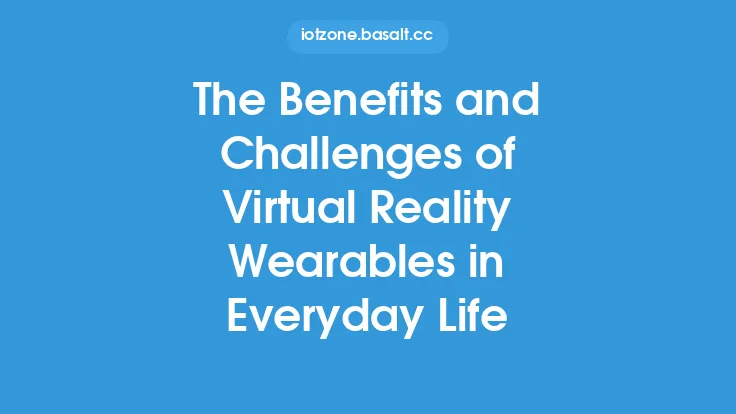The use of virtual reality (VR) wearables in therapy is a rapidly growing field that has shown tremendous promise in the treatment of various mental health disorders, phobias, and anxieties. By providing an immersive and controlled environment, VR wearables enable therapists to create customized treatment plans that cater to the specific needs of each patient. This technology has been particularly effective in exposing patients to simulated situations that would be difficult or impossible to replicate in real life, allowing them to confront and overcome their fears in a safe and controlled manner.
History of Virtual Reality Wearables in Therapy
The concept of using VR in therapy dates back to the 1990s, when researchers first began exploring the potential of this technology in the treatment of anxiety disorders. However, it wasn't until the development of more advanced VR wearables, such as head-mounted displays (HMDs) and motion controllers, that this field began to gain significant traction. Today, VR wearables are being used in a wide range of therapeutic applications, from the treatment of post-traumatic stress disorder (PTSD) and social anxiety disorder to the management of chronic pain and addiction.
Technical Requirements for Virtual Reality Wearables in Therapy
To be effective in therapy, VR wearables must meet certain technical requirements. These include high-resolution displays, advanced motion tracking systems, and comfortable, ergonomic designs. The VR experience must also be highly immersive, with realistic graphics, spatial audio, and intuitive controls. Furthermore, VR wearables used in therapy must be able to track the patient's physiological responses, such as heart rate and skin conductance, to provide therapists with valuable insights into their emotional state. Some of the key technologies used in VR wearables for therapy include:
- Head-mounted displays (HMDs): These are the primary interface between the patient and the virtual environment. HMDs must have high-resolution displays, wide fields of view, and advanced motion tracking systems to provide a seamless and immersive experience.
- Motion controllers: These allow patients to interact with the virtual environment in a natural and intuitive way. Motion controllers must be highly responsive and accurate, with advanced haptic feedback systems to simulate the sensations of touch and texture.
- Physiological monitoring systems: These track the patient's physiological responses, such as heart rate, skin conductance, and facial expressions, to provide therapists with valuable insights into their emotional state.
Applications of Virtual Reality Wearables in Therapy
VR wearables are being used in a wide range of therapeutic applications, including:
- Exposure therapy: This involves exposing patients to simulated situations that would be difficult or impossible to replicate in real life. VR wearables enable therapists to create customized exposure plans that cater to the specific needs of each patient.
- Cognitive-behavioral therapy (CBT): This involves helping patients to identify and change negative thought patterns and behaviors. VR wearables can be used to create interactive, immersive experiences that simulate real-life situations, allowing patients to practice new skills and behaviors in a safe and controlled environment.
- Mindfulness-based therapy: This involves helping patients to develop greater awareness and acceptance of their thoughts, feelings, and bodily sensations. VR wearables can be used to create immersive, interactive experiences that simulate mindfulness exercises, such as meditation and deep breathing.
Benefits of Virtual Reality Wearables in Therapy
The use of VR wearables in therapy has several benefits, including:
- Increased accessibility: VR wearables can be used in a wide range of settings, from clinics and hospitals to homes and community centers. This makes it possible for patients to access therapy from anywhere, at any time.
- Improved engagement: VR wearables can be highly engaging, making it more likely that patients will stick with their treatment plans and achieve better outcomes.
- Enhanced empathy: VR wearables can be used to create immersive, interactive experiences that simulate the perspectives and experiences of others. This can help therapists to develop greater empathy and understanding of their patients' needs and concerns.
- Reduced costs: VR wearables can be more cost-effective than traditional forms of therapy, which often require specialized equipment and trained therapists.
Challenges and Limitations of Virtual Reality Wearables in Therapy
While VR wearables have shown tremendous promise in therapy, there are also several challenges and limitations to consider. These include:
- Technical issues: VR wearables can be prone to technical issues, such as glitches, lag, and equipment failure. These issues can be frustrating for patients and therapists, and may limit the effectiveness of treatment.
- Cost and accessibility: While VR wearables can be more cost-effective than traditional forms of therapy, they can still be expensive and inaccessible to many patients.
- Limited content: There is currently a limited range of VR content available for therapy, which can limit the effectiveness of treatment.
- Regulatory issues: The use of VR wearables in therapy is still a relatively new field, and there are several regulatory issues that need to be addressed. These include issues related to patient safety, data protection, and the certification of VR therapists.
Future Directions for Virtual Reality Wearables in Therapy
The use of VR wearables in therapy is a rapidly evolving field, with several future directions to consider. These include:
- Advances in technology: Advances in VR technology, such as the development of more advanced HMDs and motion controllers, will continue to improve the effectiveness of VR wearables in therapy.
- Increased adoption: As VR wearables become more widely accepted and adopted, we can expect to see greater investment in this field, leading to the development of new and innovative treatments.
- Integration with other therapies: VR wearables will likely be integrated with other forms of therapy, such as CBT and mindfulness-based therapy, to create more comprehensive and effective treatment plans.
- Greater emphasis on patient-centered design: There will be a greater emphasis on patient-centered design, with VR wearables and content tailored to the specific needs and preferences of each patient.





